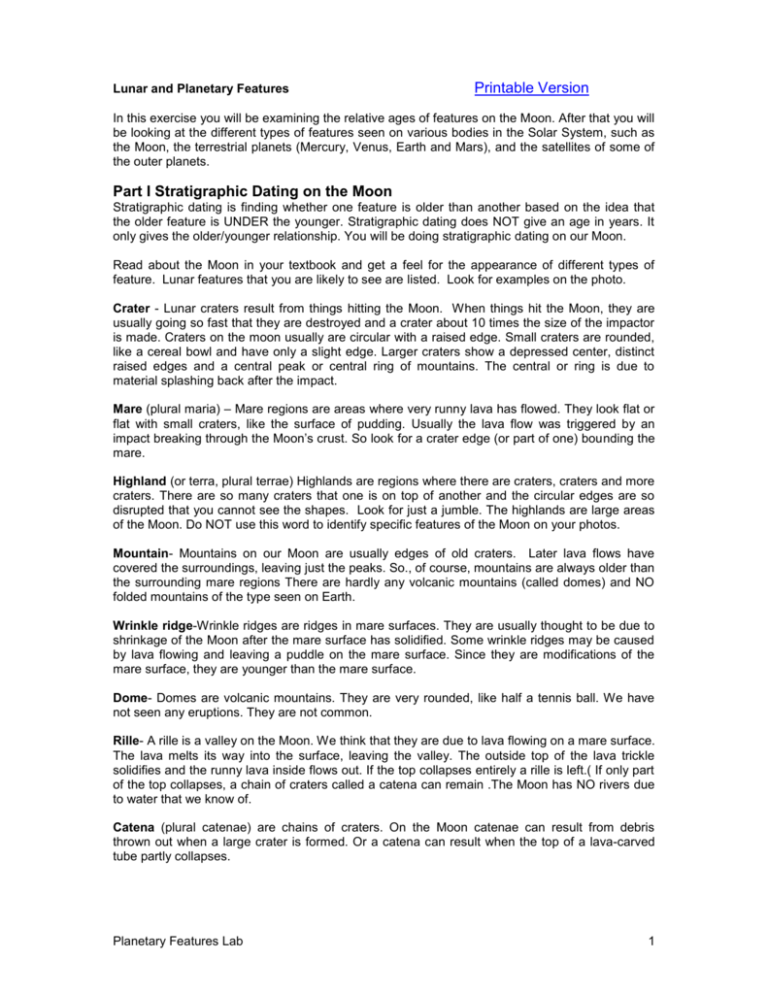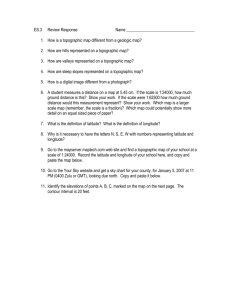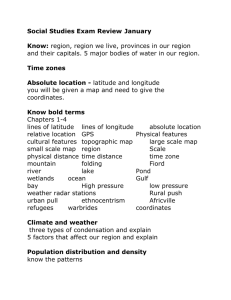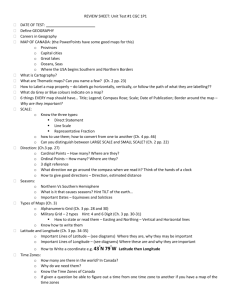Lunar and Planetary Features
advertisement

Lunar and Planetary Features Printable Version In this exercise you will be examining the relative ages of features on the Moon. After that you will be looking at the different types of features seen on various bodies in the Solar System, such as the Moon, the terrestrial planets (Mercury, Venus, Earth and Mars), and the satellites of some of the outer planets. Part I Stratigraphic Dating on the Moon Stratigraphic dating is finding whether one feature is older than another based on the idea that the older feature is UNDER the younger. Stratigraphic dating does NOT give an age in years. It only gives the older/younger relationship. You will be doing stratigraphic dating on our Moon. Read about the Moon in your textbook and get a feel for the appearance of different types of feature. Lunar features that you are likely to see are listed. Look for examples on the photo. Crater - Lunar craters result from things hitting the Moon. When things hit the Moon, they are usually going so fast that they are destroyed and a crater about 10 times the size of the impactor is made. Craters on the moon usually are circular with a raised edge. Small craters are rounded, like a cereal bowl and have only a slight edge. Larger craters show a depressed center, distinct raised edges and a central peak or central ring of mountains. The central or ring is due to material splashing back after the impact. Mare (plural maria) – Mare regions are areas where very runny lava has flowed. They look flat or flat with small craters, like the surface of pudding. Usually the lava flow was triggered by an impact breaking through the Moon’s crust. So look for a crater edge (or part of one) bounding the mare. Highland (or terra, plural terrae) Highlands are regions where there are craters, craters and more craters. There are so many craters that one is on top of another and the circular edges are so disrupted that you cannot see the shapes. Look for just a jumble. The highlands are large areas of the Moon. Do NOT use this word to identify specific features of the Moon on your photos. Mountain- Mountains on our Moon are usually edges of old craters. Later lava flows have covered the surroundings, leaving just the peaks. So., of course, mountains are always older than the surrounding mare regions There are hardly any volcanic mountains (called domes) and NO folded mountains of the type seen on Earth. Wrinkle ridge-Wrinkle ridges are ridges in mare surfaces. They are usually thought to be due to shrinkage of the Moon after the mare surface has solidified. Some wrinkle ridges may be caused by lava flowing and leaving a puddle on the mare surface. Since they are modifications of the mare surface, they are younger than the mare surface. Dome- Domes are volcanic mountains. They are very rounded, like half a tennis ball. We have not seen any eruptions. They are not common. Rille- A rille is a valley on the Moon. We think that they are due to lava flowing on a mare surface. The lava melts its way into the surface, leaving the valley. The outside top of the lava trickle solidifies and the runny lava inside flows out. If the top collapses entirely a rille is left.( If only part of the top collapses, a chain of craters called a catena can remain .The Moon has NO rivers due to water that we know of. Catena (plural catenae) are chains of craters. On the Moon catenae can result from debris thrown out when a large crater is formed. Or a catena can result when the top of a lava-carved tube partly collapses. Planetary Features Lab 1 Documenting Relative Ages-Earth’s Moon We have no absolute dates for features of most of the bodies in the solar system. We do think that the feature on top, is the youngest. When features do not overlap, we cannot always tell which is older. On the Earth we might expect that an older feature might look more worn out, but there is not so much erosion on other bodies. You will be deciding on the relative ages of some features on 2 of the images given (there are more than 2 images, they are in the Moon file). Use a small piece of paper or a 3x5 card to represent each of the features that you want to explore. Work with your partners to establish which feature is on top, which on the bottom. Lay out your cards in time order, with the leftmost position for the oldest and the rightmost for the youngest. If you cannot determine the relative age of two features, don’t connect them, put one above the other. Example (not any of the photos): You decide that features B and D are under feature E. But neither is under the other. So we don’t know whether B or D is older, but we know that both are older than E. Feature F is on top of E and G on top of F. Feature H is on top of E, but not on top of either F or G. Feature A is younger than C and C is beneath J, but none of these can be related to B or any of the others. Identify the type of object for each and show your conclusion for the age relations as shown. (Remember that this is only an example). The lines indicate the relationship between features. To the right is younger. Vertically displacements (up and down) with NO connecting line indicate that we cannot tell the age relationship. Interpreting the Images As you look at the images, be careful to distinguish what is sticking out and what is lower than the surface. Often there is no easy way to tell without making assumptions. Look for shadows and your knowledge that a crater will have a raised edge and a low middle to find the direction of the sunlight. There are lots of craters, and basically NO raised things with valleys surrounding them. Once you know the direction the light is coming from, the shadows should be consistent across the entire picture. You may either draw the diagrams on paper or do them on the computer. If you have a word processor, you may be able to draw this kind of picture (I did) or space out the text. Or you can use Power Point or Excel. The result will not be too large to email. If you don’t have any of these, draw it on paper and mail it or drop it in the mailbox at my office. Check out the photo below. Use it to learn to recognize features and their relationships. Moon pictures 1. Analyze the ages of the features of TWO pictures by identifying the type of feature and developing an age diagram for each. Both pdf and gif versions are provided. The references on the same line are for the same picture. Higher number pictures are easier. Pic 1 gif pdf Pic 5 gif pdf Pic 2 gif pdf Pic 6 gif pdf Pic 3 gif pdf Pic 7 gif pdf Pic 4 gif pdf Pic 8 gif pdf 2. Write an explanation of how to determine dates on the Moon and how to answer question 1. Write as though you are explaining to a friend, not to a teacher. Planetary Features Lab 2 EXAMPLE LUNAR PHOTO c e 10 10 1 4 8 2 6 5 9 7 3 11 15 1 crater 1 2 crater 13 3 edge of 7 4 submerged 12 8 11 crater 9 4 crater 3 5crater 2 6 crater Crater 2 might be older than 4, 12 7 partly but it is so close to 4 that it submerged probably would have been destroyed by debris 13 crater 8 mare surface 5 6 9 wrinkle ridge 10 crater 11 submerged crater 15 14 Craters 5 and 6, and 12 rille craters 15 and 14 are not 13 rille overlapping with 4 etc, 14 crater so we don’t know the age relationship 15 crater 14 Part 2 Comparing Features of Planets and Moons As we examine the features found on planets and moons in our solar system, we find both similarities and differences. At http://planetarynames.wr.usgs.gov/index.html you will find a gazetteer, a list of names of features, and maps that you can look at to see the features. Compare and contrast the features found on several objects. Choose three objects available from this site. Choose ONLY objects which give the coordinates of features and which have photos. Compare and contrast the types of feature found on each of the objects that you have chosen. If you are working with a partner or several partners, be sure that there is AT LEAST one different object for each of you. Look at the list of types of types of feature for your various objects. Use the type of feature to decide whether they are the same or different. Consider the features on three different objects. Find four features on each of three objects. Use objects where latitude and longitude are given and where there are photographs (not every object has this). Try to find the same type of feature (as identified by the name) on at least two, if not all of the objects. Try to find a type of feature that is on each object, but not on the others. There are extra lines in the table, but there should be 12 items total. The names of the features are the proper names, like Mare Imbrium. Planetary Features Lab 3 Q3 Name of Object Theme of Names on this object Type of Feature Type of Feature Type of Feature Type of Feature Type of Feature Type of Feature Type of Feature Type of Feature Name: Name: Name: Latitude: Longitude: Name: Latitude: Longitude: Name: Latitude: Longitude: Name: Latitude: Longitude: Name: Latitude: Longitude: Name: Latitude: Longitude: Name: Latitude: Longitude: Name: Latitude: Longitude: Name: Latitude: Longitude: Name: Latitude: Longitude: Name: Latitude: Longitude: Name: Latitude: Longitude: Name: Latitude: Longitude: Name: Latitude: Longitude: Name: Latitude: Longitude: Name: Latitude: Longitude: Name: Latitude: Longitude: Name: Latitude: Longitude: Name: Latitude: Longitude: Name: Latitude: Longitude: Name: Latitude: Longitude: Name: Latitude: Longitude: Latitude: Longitude: Latitude: Longitude: 4. Compare the appearance of one type of feature as it appears on two of your bodies. Tell the type of feature and describe the similarities and differences. Planetary Features Lab 4 5. Did you find any type of feature of that is on only ONE of the bodies? What kind of feature is it? (it probably would NOT be in your table) Part 3 Topographic Maps Topographic maps are maps of the altitude, height above a reference level. Color indicates the depth. There is no sea level on any planet except Earth, but there is an average level. You may be wondering what happened to the topographic maps of the Earth. There are lots and lots of them, but they are for sale from the US Geological survey. They can even show individual buildings in rural areas. Choose three bodies and compare their topographic maps. A list of topographic maps is provided after the table. It is NOT necessary to use maps of the same objects where you analyzed the features. A few of the topographic maps have no names for the features. So if you are using one of these, you will not be able to give names. Name of body Color for the highest features Height for the highest features Example of high feature Color for the lowest feature Height (below level) for the lowest level Example of low feature Reference you used. for Feature name Feature name Feature name Lat. Long. Lat. Long. Lat. Long. Feature name Feature name Feature name Lat. Long. Lat. Long. Lat. Long. map Maps to use for features and topographic information Please Report Broken Links Amalthea topographic jpg pdf Io pdf Janus topographic jpg pdf Mars topographic jpg pdf Mars MOLA (laser altimeter data, much like topographic and usable for topographic) pdf Mars topographic with names http://ralphaeschliman.com/ Miranda map jpg pdf Proteus topographic map jpg pdf Venus topographic map with names Venus topographic and relief maps with names http://ralphaeschliman.com/ Planetary Features Lab 5








